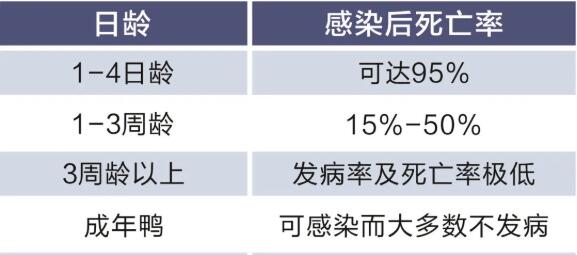
What is duck hepatitis?
Duck viral hepatitis (DHV) is a highly contagious disease that causes acute death of ducklings caused by duck hepatitis virus. Clinically, it is characterized by rapid onset, convulsions, acute death, liver swelling, and bleeding. The most typical symptom is opisthotonus after death. The disease has three serotypes: I, II and III. Our country has always been dominated by types I and III.

Virus characteristics
Duck hepatitis virus belongs to the Picornaviridae family. The nucleocapsid of this virus is a symmetrical icosahedron, without envelope covering, and it is a single-stranded positive-strand RNA virus. The virus has strong resistance and can resist organic solvents such as ether, chloroform, etc.; it can tolerate trypsin and 30% methanol; it can be completely inactivated by heating at 56°C for 23 hours, but it can be completely inactivated by heating at 62°C for 30 minutes. Inactivate all of them; commonly used disinfectants include: 0.1% formalin, 2% Lysol, 20% anhydrous sodium carbonate, etc.

Popular features
The disease mainly infects ducklings and can spread rapidly among susceptible ducks. It can be transmitted through the digestive tract, cloaca and respiratory tract. It has no seasonality and can occur all year round. The incidence rate is high, but the mortality rate increases with time. The mortality rate decreases with increasing age. Ducklings aged 1-4 days usually die within 1-4 days after the onset of illness, with a mortality rate of up to 95%, while the mortality rate of ducklings aged 1-3 weeks after infection is only 15% - 50%, the morbidity and mortality rate are very low for those over 3 weeks old, and adult ducks have certain resistance to it.

Clinical symptoms
The disease has a short incubation period, rapid onset and rapid spread. Usually around 24 hours after infection, symptoms such as depression, drooping of the neck, slow movement, and reduced food intake will appear. Neurological symptoms will gradually appear, the legs will be stretched back, the head will gradually tilt back, and death will occur soon. Adult ducks do not show clinical symptoms, mostly have latent infection, and detoxify for a long time.
Pathological changes:
An autopsy of the dead ducklings showed that the lesions were mainly on the liver of the ducklings, which showed enlargement of the liver, yellow color, pinpoint-sized bleeding spots and bleeding spots, which are its characteristic lesions; the gallbladder was filled with green bile and was obviously Swelling, with white necrosis on the surface or cut surface of the pancreas. The kidneys are swollen, pale in color, bulged in section, and have everted edges.
Prevention
NO.1
Strengthen feeding management, establish a strict sanitation and disinfection system, and improve epidemic prevention awareness. It is recommended that duck farms use self-breeding and self-raising methods for breeding. If ducks must be introduced, they must be purchased from regular channels. It is best to adopt an all-in, all-out system for duck houses and raise them in groups according to age.
NO.2
This disease can be prevented with a vaccine. Breeding ducks are immunized with attenuated vaccine for the first time one month before giving birth, and boosted once 2 weeks later. Each intramuscular injection of 1 ml can provide maternal antibodies to offspring ducklings, but maternal antibodies are not enough to completely protect the offspring. It is recommended to inject 0.5-1ml of duck hepatitis A virus bivalent yolk antibody into ducklings when they are 1-3 days old, which can have a good preventive effect.
NO.3
Once the disease develops in ducklings, duck hepatitis A virus bivalent yolk antibodies should be quickly injected with a dosage of 1-2ml/bird (the dosage is adjusted according to the age of onset), which can quickly and effectively reduce mortality and prevent the spread of the pathogen.


Luoyang Wopsen Bioengineering Co., Ltd. is a high-tech veterinary biological products enterprise focusing on the research and development, production, sales and technical services of therapeutic and preventive veterinary biological products.
The company has built a standardized GMP production workshop, quality inspection center and experimental animal center. It has passed the new version of GMP certification of the Ministry of Agriculture and Rural Affairs, won the title of National Science and Technology Small and Medium-sized Enterprises, and was the first to establish an enterprise research and development center for green therapeutic drugs for animals.